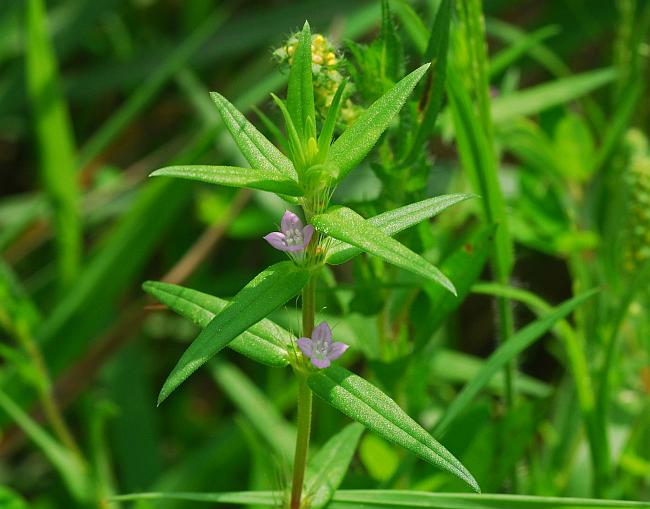Diodia teres Walter
Rough Buttonweed

Native
CC = 2
CW = 5
MOC = 68
© SRTurner
Diodia teres WalterRough Buttonweed | |
 |
Native CC = 2 CW = 5 MOC = 68 |
© SRTurner |
|
Family - Rubiaceae Habit - Annual forb, sometimes woody at base. Stem - Ascending to erect, to 35 cm, 4-angled, minutely roughened or sparsely to moderately pubescent with short, straight to wavy hairs of various lengths.
Leaves - Opposite, simple, sessile, entire. Stipules 1-2 mm long, spanning node and fused to leaf bases on either side, each side bearing 5-11 bristles on the margins, variously 1-10 mm long. Leaf blades 1.0-3.5 cm long, 2-5 mm wide, narrowly lanceolate to narrowly elliptic or nearly linear, angled to somewhat rounded at the base, angled to a sharply pointed tip, the margins minutely pubescent with stiff, spinescent hairs, frequently becoming revolute (especially in dry microsites), the surfaces glabrous or nearly so, the venation with the midvein and usually 2 or 3 pairs of pinnate, secondary veins visible.
Inflorescences - Axillary flowers, usually solitary, produced at most of the nodes.
Flowers - Calyces deeply 4-lobed, the lobes 1-2 mm long, triangular, often unequal. Corollas funnelform, 6-7 mm long, pink to less commonly pale purple, externally glabrous or hairy, internally glabrous, the tube 4-5 mm long, the lobes 2.0-2.5 mm long, lanceolate. Stamens 4, inserted near the top of the corolla tube. Ovary fully inferior, 2-locular, the ovules 1 per locule. Styles unbranched, with a 2-lobed, capitate stigma.
Fruits - Schizocarps 3.0-3.5 mm long, 3.0-3.5 mm wide, broadly obovoid, smoothly rounded to broadly angled on the sides, splitting into 2 mericarps.
Flowering - June - October. Habitat - Glades, upland prairies, sand prairies, bluffs, streambanks, pastures, old fields, railroads, roadsides, open disturbed areas, often in sandy or acidic soils. Origin - Native to the U.S. Lookalikes - Sherardia arvensis. Other info. - This little species is common across most of Missouri except for the northwestern corner of the state. Missouri is near the northwestern corner of the plant's main range, which occupies the southeastern quadrant of the continental U.S. It is found, less commonly, in southwestern regions of the U.S. and continues into Central and South America. Photographs taken at Hawn State Park, Ste. Genevieve County, MO, 9-1-2008, Canaan Conservation Area, Gasconade County, MO, 8-13-2013, and at Sand Prairie Conservation Area, Scott County, MO, 8-15-2021 (SRTurner). |